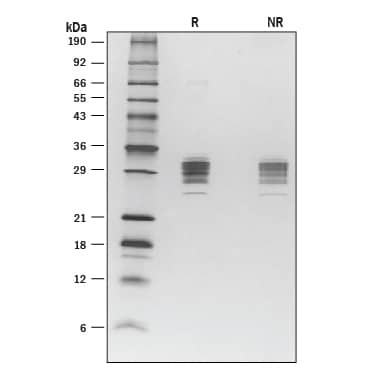Recombinant Mouse Angiopoietin-like 3 (aa 17-220), CF
R&D Systems, part of Bio-Techne | Catalog # 8344-AN

Key Product Details
Product Specifications
Source
Chinese Hamster Ovary cell line, CHO-derived mouse Angiopoietin-like Protein 3/ANGPTL3 protein
Ser17-Thr206, with a C-terminal 6-His tag
Ser17-Thr206, with a C-terminal 6-His tag
Purity
>95%, by SDS-PAGE visualized with Silver Staining and quantitative densitometry by Coomassie® Blue Staining.
Endotoxin Level
<0.10 EU per 1 μg of the protein by the LAL method.
N-terminal Sequence Analysis
Ser17
Predicted Molecular Mass
23 kDa
SDS-PAGE
23-37 kDa, reducing conditions
Activity
Bioassay data are not available.
Scientific Data Images for Recombinant Mouse Angiopoietin-like 3 (aa 17-220), CF
Recombinant Mouse Angiopoietin-like 3 (aa 17-220) SDS-PAGE
1 μg/lane of Recombinant Mouse Angiopoietin-like 3 (Catalog # 8344-AN) was resolved with SDS-PAGE under reducing (R) and non-reducing (NR) conditions and visualized by silver staining, showing both R and NR bands at 23-37 kDa.Formulation, Preparation and Storage
8344-AN
| Formulation | Lyophilized from a 0.2 μm filtered solution in MOPS,NaCl and CHAPS. |
| Reconstitution |
Reconstitute at 100 μg/mL in PBS.
|
| Shipping | The product is shipped at ambient temperature. Upon receipt, store it immediately at the temperature recommended below. |
| Stability & Storage | Use a manual defrost freezer and avoid repeated freeze-thaw cycles.
|
Background: Angiopoietin-like Protein 3/ANGPTL3
References
- Santulli, G. (2014) Front. Endocrinol. (Lausanne) 5:4.
- Conklin, D. et al. (1999) Genomics 62:477.
- Ge, H. et al. (2005) J. Lipid Res. 46:1484.
- Ono, M. et al. (2003) J. Biol. Chem. 278:41804.
- Koishi, R. et al. (2002) Nat. Genet. 30:151.
- Essalmani, R. et al. (2013) J. Biol. Chem. 288:26410.
- Quagliarini, F. et al. (2012) Proc. Natl. Acad. Sci. USA 109:19751.
- Shimizugawa, T. et al. (2002) J. Biol. Chem. 277:33742.
- Shimamura, M. et al. (2007) Arterioscler. Thromb. Vasc. Biol. 27:366.
- Koster, A. et al. (2005) Endocrinology 146:4943.
- Inaba, T. et al. (2003) J. Biol. Chem. 278:21344.
- Shimamura, M. et al. (2004) Biochem. Biophys. Res. Commun. 322:1080.
- Fugier, C. et al. (2006) J. Biol. Chem. 281:11553.
- Matsusue, K. et al. (2006) Mol. Cell Endocrinol. 256:23.
- Camenisch, G. et al. (2002) J. Biol. Chem. 277:17281.
- Zhang, C.C. et al. (2006) Nat. Med. 12:240.
Alternate Names
AGNPT5, Ang-5, Angiopoietin-5, ANGPTL3
Gene Symbol
ANGPTL3
UniProt
Additional Angiopoietin-like Protein 3/ANGPTL3 Products
- All Products for Angiopoietin-like Protein 3/ANGPTL3
- Angiopoietin-like Protein 3/ANGPTL3 cDNA Clones
- Angiopoietin-like Protein 3/ANGPTL3 ELISA Kits
- Angiopoietin-like Protein 3/ANGPTL3 Lysates
- Angiopoietin-like Protein 3/ANGPTL3 Primary Antibodies
- Angiopoietin-like Protein 3/ANGPTL3 Proteins and Enzymes
- Angiopoietin-like Protein 3/ANGPTL3 Simple Plex
Product Documents for Recombinant Mouse Angiopoietin-like 3 (aa 17-220), CF
Product Specific Notices for Recombinant Mouse Angiopoietin-like 3 (aa 17-220), CF
For research use only
